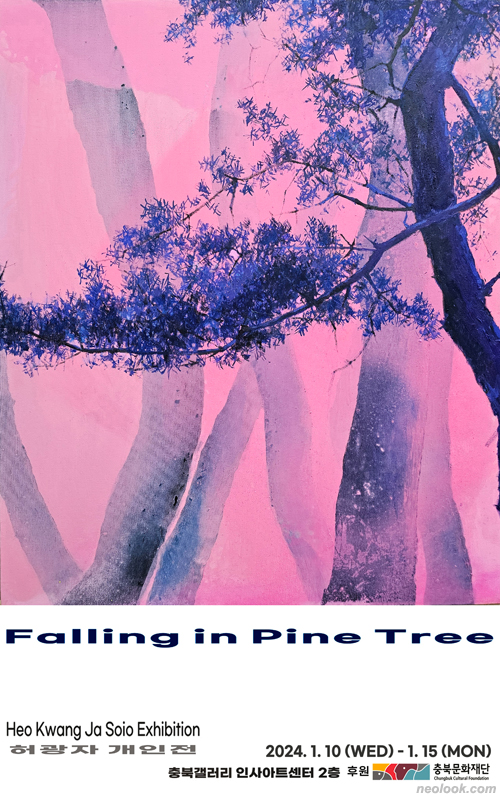- ● homepage
- ● archives
- ● restoration
- ● books
- ● big banners
- ● post board
- ■ neo's search
- ■ about us
- ■ 게재방법 안내
- 개인정보처리방침

- [email protected]
- Tel. 02_335_7922
- Fax. 02_335_7929
- 10:00am~04:30pm
- 월요일~금요일
- 3/3(월) 대체공휴일

Falling in Pine Tree
허광자展 / HEOKWANGJA / 許光子 / painting 2024_0110 ▶ 2024_0115
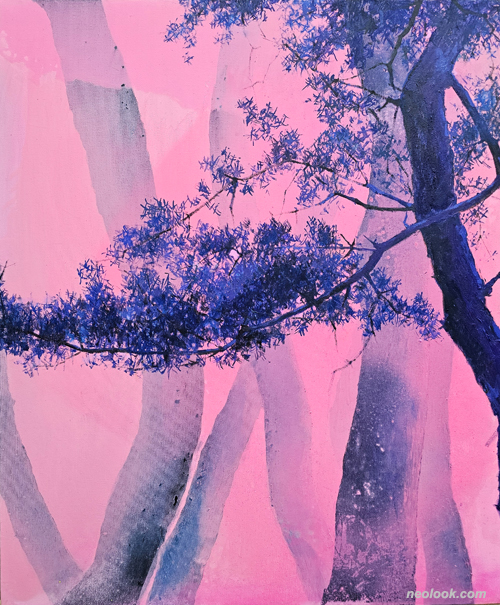
- 허광자_Falling in Pine Tree-Color_캔버스에 유채_72.7c×60.6m_2023
별도의 초대일시가 없습니다.
후원 / 충청북도_충북문화재단 기획 / 허광자
관람시간 / 10:00am~07:00pm
충북갤러리 CHUNGBUK GALLERY 서울 종로구 인사동길 41-1 인사아트센터 2층 Tel. 070.4224.6240 www.cbartgallery.com
다층적 공간에 자리한 소나무 ● 대략 2000년도 중반 이후부터 지금까지 작가는 소나무만을 소재로 이를 재현해왔다. 특정 소재를 반복해서 자기 작업의 핵심적인 모티프로 삼으면서 이를 지속적으로 변주하고 기법상의 여러 변화를 시도하면서 현재에 이르고 있다. 작가에게 소나무는 개인적으로 유년의 기억과 긴밀하게 연동되어 있다고 한다. 어린시절의 원초적 지각을 규정하는 공간적 체험과 함께 고향과 부모와 얽힌 여러 사연과 향수를 동시에 안겨주는 원형적인 이미지의 하나가 바로 소나무였던 것 같다. 소나무는 한국의 자연공간을 대부분 점유하고 있는 대표적인 수종인 동시에 한국인들의 삶과 문화 속에서 오랜 세월 함께 해온 존재이다. 한국인들은 소나무로 둘러싸인 공간에서 태어나 소나무로 만든 집과 가구를 비롯해 다양한 일상의 생활용품을 사용해왔고 소나무와 얽힌 여러 설화와 문화적 상징들의 체계 속에서 삶을 도모해온 역사를 간직해 오고 있다. 따라서 소나무는 단순한 나무에 머물지 않는다. 그것은 한국인에게 상당히 특별한 존재로서 풍부한 의미를 부여받으며 그림의 소재로도 널리 다루어져 왔다. ● 소나무를 소재로 한 그림은 전통시대뿐만 아니라 여전히 동시대 한국현대미술 속에서도 부단히 출몰하고 있다. 다양한 이미지 속에서 소나무는 거듭 재생산되고 재해석되기를 거듭한다. 그런데 문제는 소나무에 대한 코드화나 사회적 관습의 시선이 아니라, 소나무에 부여된 인습적 시선이 아니라 작가 개인의 새로운 시각이나 해석 내지 스투디움에 반하는 풍툼(punctum), 그러니까 '코드가 부재하는 비표상성의 세계'를 펼쳐놓는 것일 것이다.

- 허광자_Falling in Pine Tree-Color_캔버스에 유채_53×33.4cm_2023
한국 산야에 놓인 특정 소나무를 중심에 설정하고 주변 풍경을 뒤로 물린 작가의 초기 풍경화는 계절의 변화와 시간의 추이 속에 자리한 소나무의 자태를 묘사하는 동시에 그로인해 번지는 정서적 느낌 등을 겨냥하면서 이루어지고 있다는 인상이다. 여행이나 답사에서 마주친 소나무를 '발견'하고 이를 사진으로 담은 이후에 이것을 기반으로 재현한 것이다. 그러니까 작가는 의도적인 여행을 통해 소나무를 찾고 그 이미지를 사진으로 채집한 후 이를 다시 그림으로 해석/만드는 일을 하고 있다. 작가는 말하기를 당시의 그림이 산책자의 시선에서 포착한 소나무이기에 그림을 감상하는 이들 역시 무심한 관조 속에서 소나무를 바라보기를 권하고 싶었다고 한다. 당시 카메라 시선에 의지한 것은 가능한 한 대상을 주관적인 데서 벗어나 객관적인 것, 무심하게 관조하려는 의도에서였다고 한다. 그래서 그림은 전체를 평등하게, 균질하게 펼쳐 보이는 편이다. 그러나 사진의 객관성이나 사실성과 함께 한 축으로는 자연에서 느끼는 정서적 측면(자연에서 느끼는 두려움 내지 고독감, 막막함 등)을 그림 안에 밀어넣으려는 시도가 공존하고 있기도 하다.
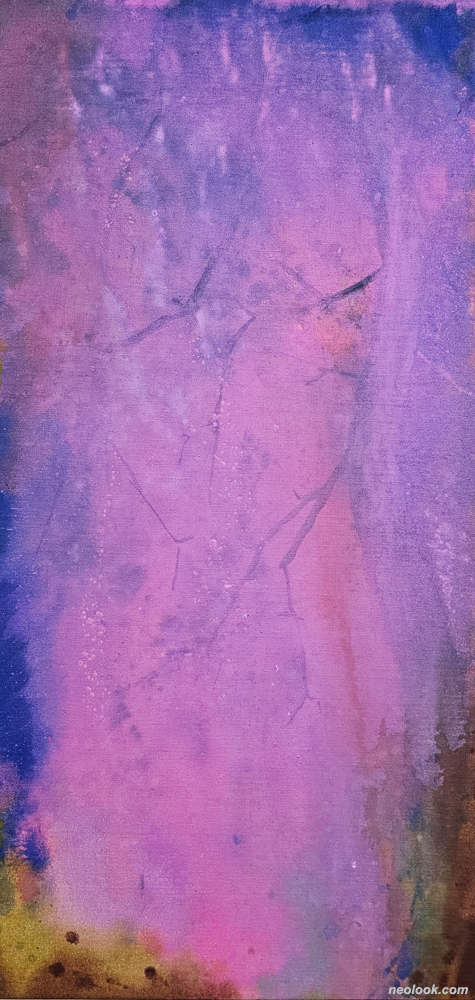
- 허광자_Falling in Pine Tree-Color_캔버스에 유채_100×50cm_2023
2015년 이후의 작업은 이전과는 사뭇 다른 양상을 보이고 있다. 소나무를 풍경으로부터 배제시키고 소나무 자체만을 독립적으로 화면에 올려놓고 있다. 당연히 배경은 단색으로 마감되어 있거나 특정 장소를 지우고 소나무의 형상만을 두드러지게 강조하는 형국이고 이는 소나무의 형태적 특성이나 개성을 의식적으로 주목시킨다. 그것은 마치 소나무 자체를 분리해서 다룬 정물화와도 같은 느낌을 안겨준다. 동시에 대지로부터 솟아오르는 기세 내지 기의 흐름을 가시화하는 이른바 동양화적인 속성도 은연중 드리우고 있다. 여백과도 같은 배경 처리나 소나무의 윤곽과 배경의 경계선이 다소 모호하게 처리되는 것도 흡사 운무가 가득한 데서 솟아오르는 소나무의 생성적인 흐름 같은 것을 연상시키기도 하고 가시적인 존재에서 비가시적인 것의 갈래를 추적하게 만든다.
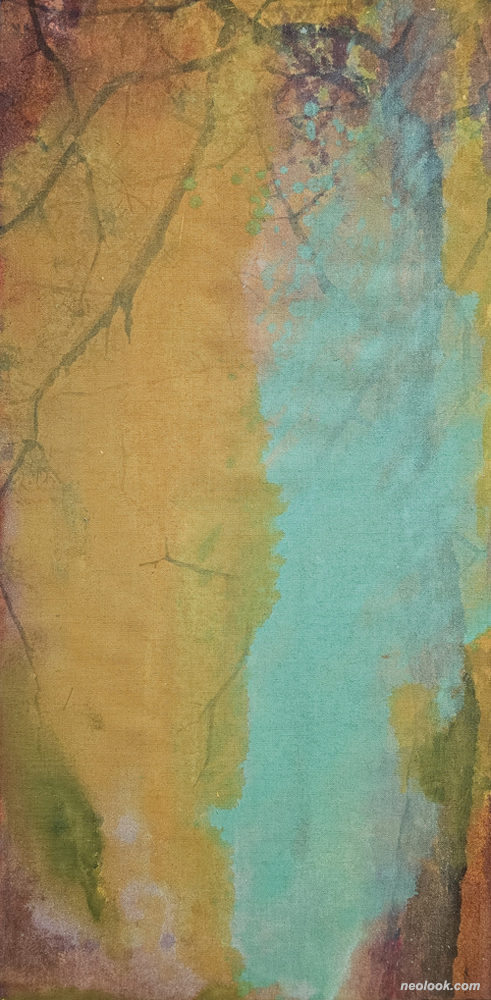
- 허광자_Falling in Pine Tree-Color_캔버스에 유채_100×50cm_2023
작가의 최근작은 크게 두 가지로 구분되는데 하나는 그려진 소나무를 의도적으로 지우는 작업이고 다른 하나는 전경과 후경을 만들어놓고 배경을 사라지게 하는 식이다. 납작한 평면의 화면에 일종의 막을 만들고 그로인해 또 다른 공간을 가설하고 환영을 부여하는 연출이자 동시에 특정한 대상의 재현이 안기는 이해의 직접적이고 단선적인 통로에서 벗어나 보다 다층적이고 모호한 감성의 접근 내지 다양한 해석과 사유의 촉발을 자극하기 위한 모색이라고 보여진다. 그것은 관자의 개입과 참여를 촉발시키는 편이기도 하다. 여전히 재현적인 기법을 구사하면서도 이를 내파하면서 다층적이고 다성적인 보여짐의 공간을 조성하려는 시도라는 생각도 든다. ● 생각해보면 그려진 소나무의 표면을 여러 겹의 물감을 입혀서 지우는, 베일링 하는 행위를 통해 부분적으로 은폐하고 지우는 일은 본래의 형태 자체를 또 다른 존재로 발생시키는 일이기도 하다. 그것은 동시에 흔적, 상처를 입히는 일이기도 하다. 무수한 붓질, 물감의 덧입힘에 의해 소나무는 지워지거나 부식되는데 그럼에도 불구하고 부분적으로 몸통과 가지는 여전히 잔해처럼 남아 자신의 본래 존재를 방증한다. 그것은 흡사 지워지지 않는 추억이나 기억, 향수와도 같이 맴돌기도 하고 생명의 본질적인 힘을 방사하며 떠돌다가 무수한 시간의 힘들을 기억시킨다. 한편 여러 번의 붓질에 의해 두터워진 물감으로 인해 발생한 촉지적인 질감 위로 보는 이의 시선이 낙하하면서 관조적인 시선 외에 촉각적 시선이 발생한다.
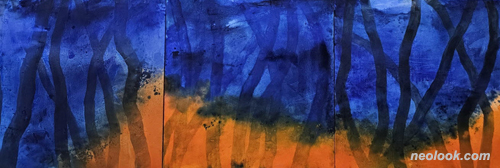
- 허광자_Falling in Pine Tree-Time_캔버스에 유채_91×273cm_2023
그런가하면 작가는 전경과 후경을 대조시키면서 비교적 선명하게 재현한 전경의 소나무와 마치 안개 속에 박혀있는 듯한 후경의 소나무를 극적으로 연출한다. 그려진 그림과 색채로 얼룩진 화면이 공존하는 느낌도 들고 사실적으로 재현된 대상과 개략적으로 단순화된 선/색이 대비를 이루는 화면 구성이자 평면적인 화면에 깊은 심연을 가설하는, 따라서 보는 이들로 하여금 특정 대상을 보는 동시에 대상의 실루엣 내지 무無를 보고 있는 것과 같은 체험을 안긴다. 소나무를 보면서 동시에 화면 안쪽의 부재를 동시에 마주대하고 있는 것이다. 그리고 이 소나무의 선들은 보다 단순화되고 기호화되어 가는 모종의 추이를 보여주고 있다. 소나무의 특성과 개성을 소거한 채 꿈틀거리는 선으로만, 기세나 기의 흐름으로만, 유동적인 곡선의 질주로만 등장하는 최근작은 초기의 재현적인 소나무의 형상이 종내 생성적인 흐름으로만 포착되고 있다는 생각이다. 그리고 이는 생성론적 차원에서 존재를 인식하는 동양적 사유패턴의 한 편린을 강하게 연상시켜준다. 그림은 가시적 세계에서 비가시적 존재를 해명하는 일이다. 작가는 오랜 시간 소나무를 소재로 이를 재현해오면서 단지 소나무의 외형, 외피만을 모방하고 연출하기보다는, 그것에 달라붙은 감성적인 문화적 관습이나 코드화에 길들여지기보다는 가능한한 대상의 이면에 자리한 보이지 않는 상처, 흔적, 풍툼을 가시화하려는 시도를 진행형으로 선보이고 있다는 생각이다. ■ 박영택
Pine Tree in a Multi-Layered Space ● Since about the mid-2000s, the artist has reproduced this using only pine trees. It has repeatedly used certain materials as a key motif in its work, continuously changing them and attempting various changes in techniques to this day. It is said that pine trees are personally closely linked to childhood memories to the author. Along with the spatial experience that defines the original perception of childhood, it seems that one of the circular images that brings various stories and nostalgia related to hometown and parents at the same time was pine trees. Pine trees are representative species that occupy most of Korea's nature space and have been together for a long time in the lives and culture of Koreans. Koreans were born in a space surrounded by pine trees and have used various daily necessities, including houses and furniture made of pine trees, and have a history of promoting life in a system of various folk tales and cultural symbols related to pine trees. Therefore, pine trees do not stay in simple trees. It is given rich meaning as a very special existence to Koreans and has been widely treated as a subject matter of painting. ● Paintings based on pine trees are still appearing not only in the traditional era but also in Korean contemporary art. In various images, pine trees are repeatedly reproduced and reinterpreted. However, the problem will not be the coding of pine trees or the view of social customs, but rather the traditional view given to pine trees, but the artist's personal perspective, interpretation, or punctum, that is, the "world of representation without code." ● The artist's early landscape paintings, which set a specific pine tree in the Korean mountains and bitten the surrounding landscape back, are aimed at the emotional feeling of pine trees in the change of season and time. It was reproduced based on this after "discovering" pine trees encountered during travel or exploration and taking pictures of them. Therefore, the artist is working on finding pine trees through intentional travel, collecting the images as pictures, and interpreting / making them into paintings again. The artist said that since the painting at the time was a pine tree captured from the perspective of a walker, he/she also wanted to recommend that those who appreciate the painting look at the pine tree in a casual contemplation. At that time, it is said that relying on the camera's gaze was intended to look at the object as objectively as possible, away from subjectivity. Therefore, the painting tends to spread out the whole equally and uniformly. However, along with the objectivity and realism of photography, there are also attempts to push the emotional aspects of nature (feeling in nature fear, loneliness, hopelessness, etc.) felt in nature into the painting. ● Work since 2015 is showing a very different pattern from before. Pine trees are excluded from the landscape, and only pine trees themselves are independently placed on the screen. Naturally, the background is finished in a single color, or it erases a specific place and emphasizes only the shape of the pine tree, which consciously draws attention to the morphological characteristics and individuality of the pine tree. It feels like a still life painting that separates the pine tree itself. At the same time, the so-called orientalistic attribute that visualizes the flow of momentum or energy rising from the earth is also implicitly cast. The margin-like background processing or the somewhat ambiguous boundary between the outline and the background of the pine tree reminds us of a generative flow of pine trees rising from a cloud-filled place, and it traces the branches of the invisible in visible existence. ● The artist's latest work is largely divided into two categories: one is intentionally erasing the drawn pine tree, and the other is to create a foreground and a hind view and make the background disappear. It is seen as a production that creates a film on a flat screen and creates another space and gives welcome, and at the same time, it is seen as a search to stimulate a more multi-layered and ambiguous approach to emotions or trigger various interpretations and thoughts. It also tends to trigger the intervention and participation of the official. I think it is an attempt to create a multi-layered and multi-layered space of appearance while still using reproductive techniques. ● If you think about it, partially covering up and erasing the surface of the drawn pine tree by applying several layers of paint, by veiling it, also creates another existence of the original form itself. At the same time, it's also a thing to do with marks and wounds. Pine trees are erased or corroded by countless brush strokes and additional paint, but despite this, their bodies and branches remain partially like rubble, proving their original existence. It is almost like an indelible memory, and nostalgia, and it wanders around radiating the essential power of life and remembers countless times of power. On the other hand, as the viewer's gaze falls over the tactile texture caused by the paint thickened by several brush strokes, tactile gaze occurs in addition to the contemplative gaze. ● On the other hand, the artist dramatically creates a pine tree in the foreground, which is reproduced relatively clearly, and a pine tree in the background as if it were embedded in a fog. It feels like a screen stained with drawn pictures and colors coexist, and it is a screen composition in which the object reproduced realistically and the simplified line/color contrast, and thus gives the viewer the same experience as seeing a specific object or nothing. While looking at the pine tree, it is facing the absence inside the screen at the same time. And the lines of these pine trees show some trend of becoming more simplified and symbolized. The recent work, which appears only as a wriggling line while erasing the characteristics and individuality of pine trees, only as a flow of momentum or energy, and as a flow of fluid curves, is thought to be captured only as a generative flow within the species. And this strongly reminds us of a bite in the oriental thought pattern that recognizes existence at the generational level. Painting is an explanation of the invisible existence in the visible world. Rather than imitating and directing the appearance and exterior of the pine tree for a long time, the artist has been attempting to visualize the invisible wounds, traces, and punctum behind the object as much as possible rather than being tamed by the emotional cultural customs or coding attached to it. ■ Park Yeong-taek
Vol.20240110a | 허광자展 / HEOKWANGJA / 許光子 / painting

